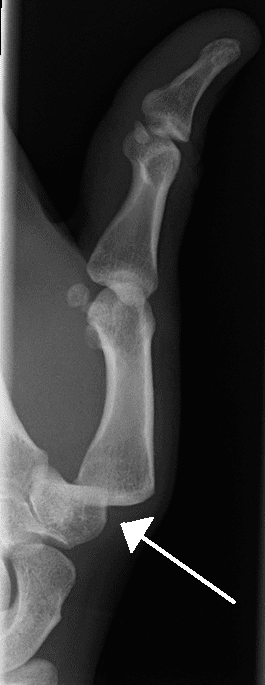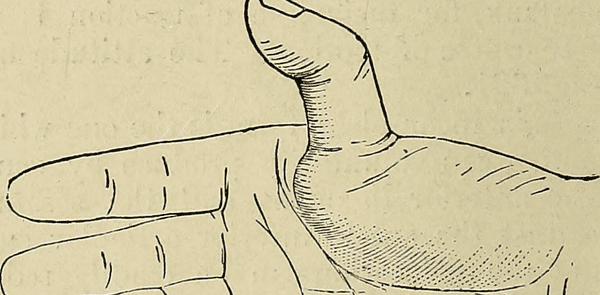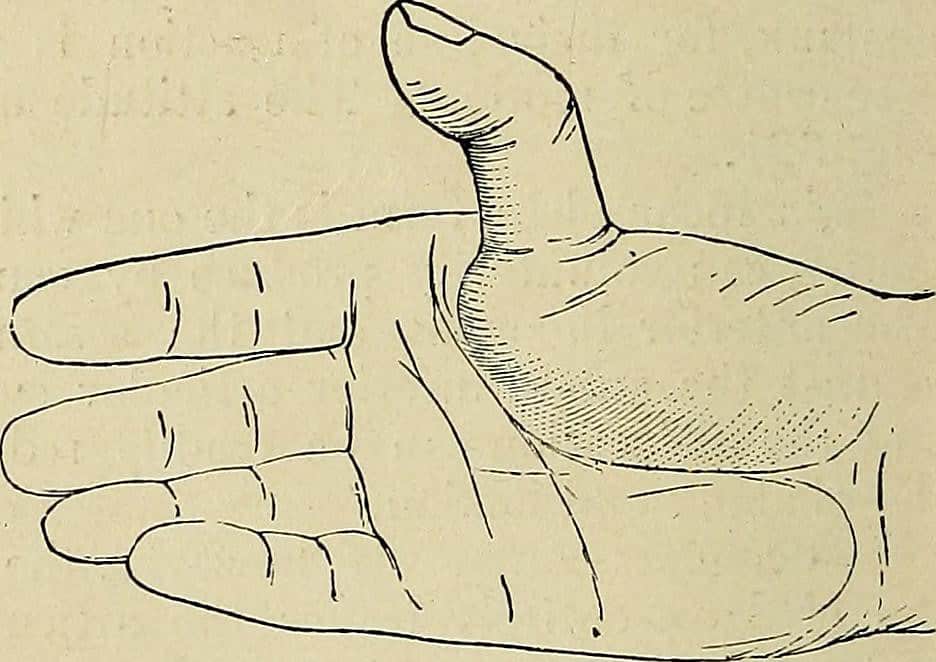Although not life-threatening, a dislocated thumb can be very painful and distressing. The sign is usually obvious, appearing crooked and swollen.
If you have a thumb dislocation, seek prompt medical attention for treatment. But feel free to use this guide to determine the symptoms, causes and recovery in the meantime.
Dislocated Thumb
 (Image Credit: Wikimedia Commons)
(Image Credit: Wikimedia Commons)
A sprained thumb can cause pain and bruising – signs that are also present in a disjointed thumb. By contrast, a dislocation is not considered a break in the bone.
It’s easy to confuse which is which, especially without proper medical treatment and a doctor’s aid. But never mistake a dislocated thumb for a sprained or broken finger. There are some differences to look for.
In a normal hand, the thumb can bend its knuckle and touch the tips of the fingers. This range of motion enables the hand to grasp and hold items easily. What is not natural is if it shifts from its true position. At this rate, the thumb has likely been out of joint.
As pointed out, a dislocation is far from fractured bones but a separation of two bones where they meet at a joint.
Causes
Thumb joint dislocations occur when the soft tissue (or ligament) that holds the joint is torn. Or when a significant force causes the ligaments to give way. The bones then move and eventually slip out of their normal placement.
This is a common injury in sports such as basketball and volleyball, where hands are involved. When catching or blocking a ball, the finger bone can easily get jammed. Once an outstretched finger gets hit, it hyperextends backward. Sports with the highest rates of hand injuries also include football and gymnastics.
Besides sports injuries, other possible causes are falls and accidents. The impact from the fall can push the fingers beyond their normal range of motion. A crushing blow, like closing the door on your finger, can also cause bones to separate from the joint.
People with unstable joints and ligaments may be at greater risk of dislocations.
Symptoms
A dislocation shows a sign of finger bones no longer together and being in an awkward direction. You may have it if:
- Limited thumb range of motion
- Noticeable palmar or dorsal ligament deformity
- Tenderness around the affected area
- Loss of finger, hand, wrist and/or grip strength
- Your thumb joint looks crooked, and your finger bone appears dislodged
- Swelling, bruising, and sharp pain around one or more of the joints
It’s important to seek medical attention as soon as possible, especially if the bones are out of place. Let a doctor assess the severity of your injury and the potential presence of any fractures.
Diagnosis
A doctor may use imaging tests, such as an X-ray or MRI, to confirm a dislocation or fracture. They’ll examine the injured finger and ask about how and when the injury occurred.
Whether through an X-ray or MRI, this will help evaluate the extent of the soft tissue damage. Plus, what causes the severe pain you may be feeling.
In an X-ray, your hand will go through electromagnetic radiation to verify displacement. Whereas an MRI scan is only needed if they suspect significant tissue damage.
Blood tests may also be required if there’s a possible infection.
Treatment
Treatment options vary depending on the severity and location of the dislocation. But immediately after the incident, avoid popping the finger back into the joint. You could injure underlying structures and worsen the condition, such as:
- Blood vessels
- Integrity of tendons
- Nerves
Get medical help right away. Here are some things you may expect a trained medical professional may carry out:
- Reduction. This procedure involves carefully repositioning the bone back into its proper place. You may be given a local anaesthetic to numb your pain before the non-surgical repair. It usually takes a few weeks to heal.
- Immobilisation. After the non-surgical reduction, you’re likely to wear a thumb spica splint. This support will help protect and immobilise the injured thumb while it heals.
- Surgery. A dislocated thumb that involves torn ligaments, fractures or broken may need surgery. An option only used when closed reduction fails to stabilise the joint. This surgical treatment is known as open reduction. This aims to reduce, stabilise and restore mobility without damaging surrounding structures. Recovery time may significantly increase.
Once the joint is back in its normal place again, it’ll take about 6 to 8 weeks (or more) for the ligaments to heal. During this time, your thumb should be protected from re-injury, hence the splint or cast. The thumb support should not be left in place longer than 3 weeks to avoid stiffness and loss of joint function.
Finger exercises may be prescribed at your follow-up appointment in the next 2 to 3 weeks or as advised. It may take 12 to 18 months for the mild pain and swelling to go away and for full function returns.
Note: Before taking over-the-counter pain relievers, talk with your doctor. They’ll determine if such oral medications are right for you.
Round-up
Knowing what to do to prevent aggravation can help heal the injured thumb faster. But a person should not attempt to relocate the dislocated finger themselves. A trained doctor, mainly an Orthopaedic, can only provide an accurate treatment plan.
Don’t use this content to self-diagnose or self-treat your condition. Most importantly, to avoid going to your doctor or to replace the advice they give you.



 (
(